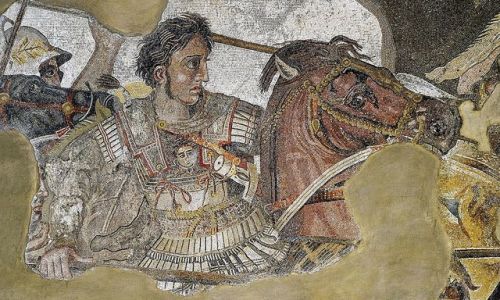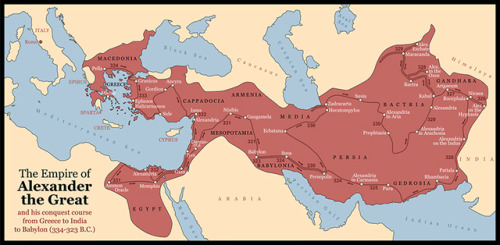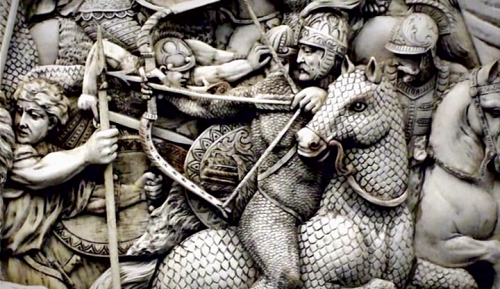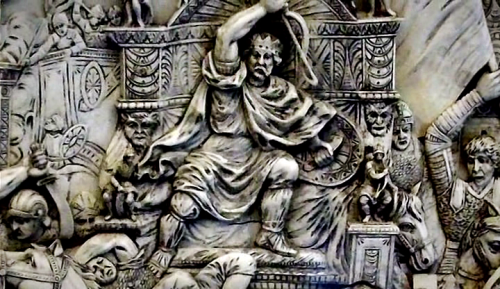#persian empire
Detail of Shirin, Queen of the Sassanian Empire, bathing. The hooves of the horse of King Khosrow can be seen at the top right. From the Kashmir Manuscript, 1791.
Shirin was the wife of Khosrow II, the shahanshah, or King of Kings, of the Sassanian (Persian) Empire. Her exact cultural/ethnic origins are debated; some sources say she was Roman (at her time that was the Byzantine Empire who considered themselves Roman) and others say she was Aramean, a non-Persian from the areas of Assyria and Babylonia.
What is known is that she was a Christian and Khosrow was Zoroastrian and that such a relationship was considered forbidden. Through all the turmoil in their lives, Shirin and Khosrow remained together. During that time she was able to gain support for the Christian minority in the empire.
Her and Khosrow’s lives and romance are retold, with fictional elements, in the Persian epic poem Shahnameh, the romance Khosrow and Shirin by the famed poet Nizami Ganjavi, and even in One Thousand and One Nights.
~Hasmonean
Post link
What was Sparta up to during Alexander the Great’s Conquests?
During Alexander the Great’s conquest of what was then the known world, the Spartan’s contributed nothing to the conquest. Rather, when Alexander the Great marched off to war, the Spartan’s refused to participate unless they were leaders of the army. So what was Sparta up to all the while Alexander was conquering the world?
According to legend Alexander’s father, King Philip II sent the following message to Sparta, “You are advised to submit without delay, for if I bring my army on your land, I will destroy your farms, slay your people and raze your city.”
The Spartan’s responded with a single word, “If”.Most likely this exchange didn’t happen, if it did then the Spartan’s were extremely naïve and stupid. Sparta during the times of Alexander was not the same Sparta as was during the Persian Wars or the Peloponnesian Wars. Spartan weapons and tactics had become outdated and quaint. A number of military defeats followed by a few slave revolts had sapped Sparta of it’s power, leaving Sparta a secondary power at best whose glory days were far behind. The Macedonians could have easily conquered Sparta, however, there were many members of the Corinthian League who hated Sparta, thus it was decided it was best to leave Sparta out of the league because of politics.
In 338 BC Agis III became King of the Spartans, and his number one goal was to make Sparta great again. In 333, with Persian military and financial support, Agis was able to raise a 20,000 man army and defeat a small Macedonian army in Greece. Agis and his men then sailed to Crete with the intention of capturing the island and adding it to Spartan territory. With Alexander the Great’s attention focused on conquering the Persian Empire, Agis and his army was easily able to overrun the island and lay siege to it’s largest city, Megalopolis, in 331. Finally the Spartan’s had become enough of a thorn in Alexander’s side that something needed to be done about them. Alexander sent his trusted general Antipater with a force of 40,000 men to deal with the Spartans. The two armies met outside of Megalopolis for a brief battle. The Macedonian’s outnumbered the Spartans 2 to 1, and in the subsequent battle they were easily able to break Spartan lines and send the Spartan army into full retreat, killing around 5,300 Spartans in the process. Agis III died in battle, supposedly staying behind to fight to the death in order to buy his army time to escape.
After the disastrous Battle of Megalopolis, the Spartans were forced to surrender to Macedonia and join the Corinthian League, lest the Macedonians send an army to destroy Sparta. The conquest of Crete was Sparta’s last hurrah, and from here Sparta would continue to decline until conquered by the Romans in 146 BC.
Post link
Ancient Worlds - BBC Two
Episode 4 “Return of the King”
Scenes from the Battle of Gaugamela, ivory relief (anonymous artist).
TheBattle of Gaugamela(alsoBattle of Arbela) took place in 331 BC between the forces of Alexander the Great of Macedon and the Persiansled by Darius III. It was a decisive victory for the Hellenic League that decided the fate of the Persian Empire. The battle took place near Gaugamela, close to the modern city ofMosul,Iraq.
The Hellenic League was heavily outnumbered but it emerged victorious due Alexander’s superior tactics and army. Many Persian soldiers lost their lives, so many that the enemy ensured that Darius would never again raise an imperial army. Some classical sources proclaim that one of the determinant factors in the Persian’s defeat against the Macedonians was king Darius: he realised that victory was hopeless, panicked and fled the battle before any victor had been decided. Another source accounts that Darius was abandoned by his men and not -as Macedonian propaganda would say- that he let his men down (picture n. 1, detail: Darius’ flight)
The relief was sculpted in the 18th century and it was inspired by a Charles Le Brun’s painting on the same subject.
National Archaeological Museum of Spain, Madrid, Spain
Post link

Coin of Darius the Great, c 520-505 BCE.
In 522 BCE, Darius I (the Great) of Persia killed the Magian usurper Gaumâta. This secured his position as ruler of the Persian Empire.

Die Seeschlacht bei Salamis by Wilhelm von Kaulbach, 1868.
In 480 BCE at the Battle of Salamis, the Greek fleet under Themistocles defeated the Persian fleet of Xerxes I.

Denarius of Sextus Pompeius featuring his father, 40 BCE.









